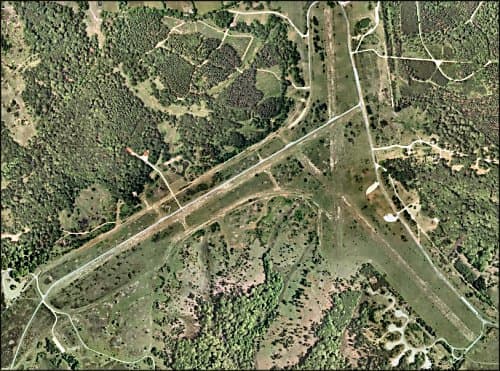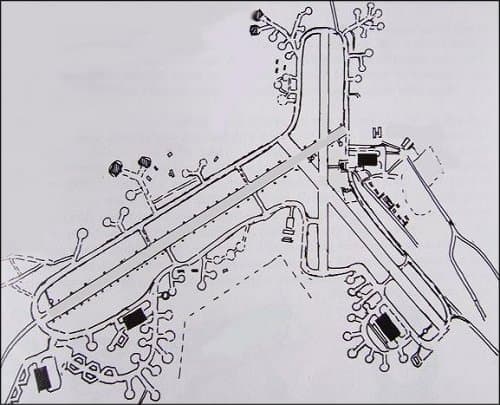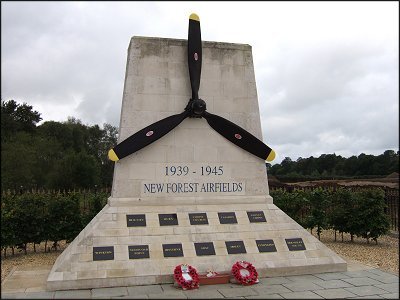Stoney Cross Airfield
Explore
Stoney Cross airfield
[OS grid ref: 2412]
Stoney Cross airfield was one of the larger wartime airfields within the New Forest, and was active between the years 1943 to 1946, with post-war activities continuing until its closure in ’48.
Stoney Cross, as with all the New Forest airfields, saw a diversity of aircraft and squadrons during its years of operation. MKI Mustangs, P-38 Lightnings, and Hurricanes were the more notable fighters flown from the airfield, while larger bombers and transport aircraft included Wellingtons, Liberators, Stirlings, and Albemarles.
From 1944 onwards, Stoney Cross changed role from being a major fighter and bomber base to playing host to Transport Command and saw many troops flown out to the Middle East.
Today, the main SW/NE (25/07) runway forms the road to Linwood and the Ocknell and Longbeech campsites make use of the airfield service roads and aircraft hardstandings and taxiways. Only recently, and sadly, the Forestry Commission removed the huge water tower at Longbeech, a familiar landmark and reminder of the airfield.
In the present day, Stoney Cross Airfield is a main area of interest in the New Forest National Park. Its large open grassy lawns are a mecca for visitors to the area, and a number of walks can be done from here.
If you do find yourself on what was once the important wartime airfield of Stoney Cross, take a minute to close your eyes and imagine the activity, the smells and the noise of the fighters and bombers of the Second World War in the New Forest.
While airfields such as Stoney Cross have their own memorial plaques, a much larger wartime memorial dedicated to all the servicemen and women (from home and abroad) of the New Forest airfields was uncovered at Holmsley airfield in August 2002:
This memorial is to be found at the western end of Holmsley South airfield, now Holmsley campsite, just off the main A35 Lyndhurst-Christchurch road. The OS grid reference for the memorial is SU212989.
Related Pages:
- RAF Ibsley Historical Group
- Friends Of The New Forest Airfields
- The New Forest at War
book.

Why Time in Nature Complements Daily Astrological Guidance
Many of us start the morning with a quick look at our horoscope. A few lines can help name our mood, highlight a tension, or point out an opening in the day. What often gets
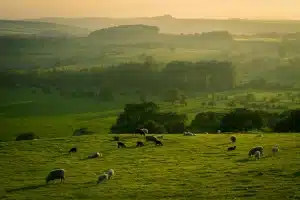
UK’s best natural spots
Wilderness escapes are not for everyone, that’s for sure. Some people simply prefer holidays where they can lounge all day and take it easy instead of being active, going hiking, swimming, or cycling. But there

Tech Hacks for Exploring the New Forest National Park
The New Forest National Park in the UK is one of Britain’s most enchanting natural destinations. Covering ancient woodlands, open heathlands, and winding walking trails, it offers visitors a chance to step back in time
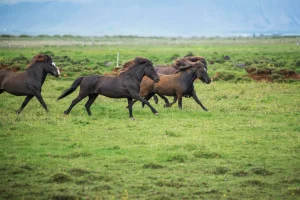
The Benefits of Outdoor Life for Horses
Life outdoors shapes stronger, healthier horses. Sunlight fuels the body with vitamin D, which helps bones grow dense and resilient. Space allows movement that stables cannot match. A horse stretching into stride, breathing clean air,

New Forest Getaway
The New Forest in southern England is unlike anywhere else, one moment you’re on a country lane, the next you’re face to face with a pony blocking traffic. Villages with thatched roofs appear out of

How Satellite Imagery is Transforming Wildlife Conservation
Today, a myriad of species and their habitats are struggling to survive and are on the verge of extinction due to permanent pressure on deforestation, climate change, and unlawful activities like illegal mining and logging.

